Adding Green to Your Routine
The Benefits of Introducing Plants and Green Spaces to Your Living and Working Environment

Nature is a part of everyone's life, whether we make the conscious effort to make it or not. We need nature on a deep and fundamental level and unfortunately, over the centuries, we have alienated ourselves from nature and other living things. Humans build cities in a fashion that is detrimental to nature and disconnects us from it. Even our homes are often built the same way.
This can cause something called "Sick Building Syndrome." This is a common problem that many people don't know about because its symptoms are often mistaken for other sources. Sick Building Syndrome is most easily defined as when a building has poor air filtration and ventilation, and little to no natural lighting. This can lead to physical ailments such as respiratory issues, concentration issues, sickness (viral infections, disease, etc.), skin disorders (rashes), and headaches. There have even been cases where this has rendered a workplace non-functional. But there is a simple way to change that.
"Biophilia" is a term that stems from the Greek words "bio" (meaning life or living things) and "philia" (meaning to have a love of or passion for), and it is an increasingly popular term used for architecture and interior design. I know this sounds like it's becoming a science article, but don't get discouraged. Biophilic design plays on our need of nature by incorporating natural elements to our man-made environments. Upon hearing this, most people often jump to how our buildings are made, their structure and efficiency. I know I did. However, while architecture and building structural design has taken a more green initiative by decreasing the buildings' environmental impact, it does not fulfill the needs of biophilic design.
Elements of Biophilic Design
Living (or green) walls, indoor gardens, and house plants are all elements of biophilic design, and they fulfill that need to be in and around nature. Humans innately feel good in nature. Our mental well-being even depends on it. These elements are great ways to bring nature back into our daily routine.
Living/Green walls: The name is its description. This is a specially designed wall made up of plants. The wall can be as big or small as you like, and it can have as many plant species as you want. These living walls have many benefits, including cleaning the air you breathe (natural filters) and providing insulation and helping to regulate building temperatures.
Indoor Gardens: When you think of a garden, you probably imagine a beautiful patch of flowers or vegetables outside in your yard. What if I told you that a garden doesn't need to be outside? Having an indoor garden can provide many benefits, including cleaning/filtering your air and beautifying the space on a completely new level. However, they do require a lot of care and can be quite costly to maintain, but the reward can be worth it.
House Plants: These are by far the most common and easy way that most people decide to introduce biophilic design to a space. They are the easiest to care for and are the easiest on your funds. House plants also clean the air, can be put anywhere, and there is huge variety.
Benefits of Adding Green
Physical Benefits: All types of plants clean/purify the air. They are natural filters and while doing so, they also increase oxygen levels. This can decrease incidences of sick building syndrome (SDS) by preventing respiratory issues and providing an energized atmosphere.
Psychological Benefits: Green spaces have been proven time and again to relieve stress, help us feel more relaxed and calm, increase productivity and mental stamina, and inspire creativity. Natural light even plays an important role in helping us regulate our moods and sleep cycles.
Have you ever been in a space that drains you of your energy and mental capacity? A space where there are no windows, no fresh air, no colour? Now have you ever gone from a space like that, to a space that is completely the opposite, with lots of natural light and fresh air? It almost immediately makes you feel better and helps to clear your head. Now imagine working and living in a space that makes you feel that good all the time. Being inside won't necessarily have to be equal to feeling depressed and drained of energy. That is the benefit of biophilic design. It improves your state of mind, and your state of living. And with a little bit of effort, you can add green to your routine and reap the rewards!
Sources
The importance of biophilic design
What is Biophilia? And why you need biophilic design in your home
Biophilic Design: The Architecture of Life










Comments
There are no comments for this story
Be the first to respond and start the conversation.